| Forest
Summit III report (Part 1) |
Edward
Frank |
| Oct
24, 2005 10:02 PDT |
ENTS,
I t has been a week since the Third Forest Summit/ENTS
Rendezvous ended in
Holyoke, Mass. From any such meeting a person brings back images
and scenes
that standout among the blur of the events. They are not always
the most
significant or important events, but ones that strike a chord
within the
individual. I want to add my notes to the
commentary on the conference.
I had to get up at a hideously early hour Thursday morning to
meet Carl
Harting in downtown Reynoldsville to ride with him to the
conference. Carl
had to get up even earlier. The trip to Massachusetts was
generally
uneventful. It was rainy and generally miserable outside, but I
was in the
passenger seat and not driving.
We arrived at the conference after the opening remarks part-way
through a
talk by Paul Pouliot on the Native American connection to
forests. He was
in the middle of a drum-song as we entered. I wish I had a
chance to see
the entire presentation. Paul is a member of the Cowasuck Band
of the
Pennacook - Abenaki People. Members of the
tribe are now scattered across
the country, but can remain in touch via the internet. One of
the themes of
his talk was the link between maintaining the language and
preserving the
culture of the people. He provided handouts listing several
books of
interest, contact information and a three page listing of Forest
Talk -
listing the words for a variety of forest trees, shrubs, and
forest concepts
in both English and Abenaki languages along with contextual
notes for each
word. There has been a portion of each
conference devoted to Native
American relationships to the forest. There is nothing on the
ENTS website
dealing with this relationship. I would really like to see a
section
devoted to these issues and concepts incorporated into the
website.
Paul's presentation was followed by James DiMaio, Chief Forester
for the
State of Massachusetts - "DCR Creating the Environment for
Forests of the
Future." Presentations by David Foster, from Harvard Forest
on "A Bold
Vision of a Forested Landscape." These talks dealt to a
large extent with
the proposed establishment of "Large Forest Reserves"
within the State of
Massachusetts - more on that later.
The next speaker was Bruce Spenser, chief forester of the
Quabbin Reservoir
Watershed for the Metropolitan District Commission. Essentially
The
watershed flows into the Quabbin Reservoir, created by damming
the Swift
River in 1939 to provide water supply for the Boston
Metropolitan area. The
Quabbin watershed is approximately 48,500 ha in extent... The
38,880 ha of
uplands on the Quabbin watershed, whether in MDC, other-public,
or private
ownership, is principally forest land. Bruce's
most telling comment was,
"You can pack the room whenever there is a meeting
concerning wildlife
management, but when the subject is forest policy, you are lucky
to get a
handful of people to show." This was in
regard to a public meeting
regarding allowing hunting in the Quabbin Forest Reservation to
reduce the
severe overpopulation of whitetail deer in the forest. Browsing
by the deer
population was preventing regeneration of the forest within the
area.
The afternoon session ended with a break for dinner. Many of us
went to an
Irish pub/restaurant located nearby. There was general
chit-chat. Lee
Frelich talked about invasive earthworms. I sat next to Ehrhard
Frost,
someone who I had not met before and a speaker scheduled for
later that
evening. There was a two member band playing oldies adjacent to
our table.
At one song Ehrhard pointed out to someone that the band was
playing a Dylan
song. I added that it was from The Byrds' "Sweethearts of
the Rodeo" album.
After dinner we headed back to the conference lectures. Ehrhard
Frost
talked on "Forest Issues, Priorities, and Practices." One
of his main
points was that if someone owns a woodlot, they really do not
need to do
anything to maintain its health. The forest would work itself
out.
The next speaker was Dr. Tabor Allison from Massachusetts
Audubon, the
countries oldest independent Audubon society (Not affiliated
with the
National Audubon Society.) he went over details
of the proposed
Massachusetts Forest Reserve System and provided more details
than the
glossy presentations earlier. The recommended size for large
forest
reserves is a minimum of 15,000 acres. This size was determined
by a study
by The Nature Conservancy (Determining the Size of Eastern
Forest Reserves,
The Nature Conservancy, 2004. ) Most of the large reserves
proposed are
smaller than that currently, but the plan is to increase their
effective
size through private land purchases and easements to the desired
sizes.
This size was determined based upon what would be required to
maintain the
reserve based upon the projected size of large scale impacts
such as forest
fires, storm damages, etc. I plan to look up the details of the
calculations to see what assumptions were made in calculating
the figures.
I can't help but wonder if the practical issue of what size
forest could be
created within Massachusetts was factored into the formula.
The establishment of a forest reserve system is a major step in
the right
direction for protecting remnants of forest within the state. I
am not from
Massachusetts so I may be freer to comment on the plan than
people involved
with its design and implementation. Dr. Allison and others
expressed that
they were unhappy with the final selection of sites for the
forest reserves.
The biggest disappointment was that Mohawk Trail State Forest
and Savoy
Forest were not included as part of a Large Forest Reserve.
Measurements by
ENTS of trees in the state and other documentation of old growth
within the
state clearly demonstrate that Mohawk Trail State Forest is the
best example
of old-growth within the state, and its absence from the Large
Forest
Reserve list is a farce. One slide provided a list of factors,
like species
diversity, to be considered when determining the ranking of a
site for
inclusion within the system and a numerical weighting for each
of the
factors. This is a reasonable approach to take. However the
weighting of
the factors seemed peculiar. The area of intact core forest,
which I think
would be a key component in establishing a forest reserve ranked
last in the
numerical weighting. I did not have time to view the slide in
detail, but
my general impression was that the weightings did not have so
much to do
with making an objective assessment, but designed to achieve a
predetermined
outcome. Even with these screwy weightings, three sites stood
out
head-and-shoulders above the others as candidates. Mohawk ranked
third.
Six reserves were selected. The first two sites were selected.
Mohawk was
not, even though four sites which ranked significantly lower on
the skewed
weighting were selected. A truthful explanation of the rationale
for not
choosing Mohawk Trail as one of the large forest reserves
selected needs to
be made by the state officials.
The next speaker was David Orwig, of Harvard Forest. He gave an
excellent
overview of the spread of the Hemlock Wooly Adegid, and
prospects for the
future spread of the pest. The final speaker was Sky Davis. She
told of
the "Houma - People of the Live Oak and the aftermath of
Hurricane
Katrina." The main village on the coast of Louisiana was
almost completely
leveled by the Katrina and they have received little outside
help, and none
from FEMA. Their economy is supported by fishing operations and
their docks
and fishing boats were destroyed. Some help has arrived from
private
sources, individuals, and some corporations like Wal-mart, but
they still
need help. The talk was an appeal for that help. United Houma
Nation
Hurricane Relief, 20986 Hwy 1, Golden Meadow, LA 70357.
After closing remarks Carl and I headed back to Monica Jakuc's
home for the
night. A number of other ENTS members stayed there as well. I
want to
thank her for her hospitality to strangers. That evening I
played for
Ehrhard and his wife some new Bob Dylan, some oldies, some guess
who is
singing, and some silly songs from a selection of MP3's on my
laptop. It
wasn't long before it was time to sleep after a long day.
Day 2 started with Bob Leverett coming into the house and
telling us we had
to get going, because we were meeting people. I had just gotten
up and was
a bit groggy. Then we were off to the woods at the William
Cullen Bryant
estate. After a stop for some breakfast where we met with some
other
people, we were off to the woods. I didn't feel to well and
opted for a nap
in the Jeep, while the others headed off to the woods to measure
trees.
After while I headed down to join them. Details
caught my eye. There was
a large paper wasp nest in the oak tree just above the entrance
to the woods
trail. I don't think anyone else even noticed. The woods itself
was a
picture in yellow and black. It had been raining for days. The
wet tree
trunks stood out as black pillars extending upward into canopy
of yellow
leaves. Yellow leaves dotted the forest floor, covered the
understory of
maples, and when the wind blew more yellow leaves fell from the
sky. Other
colors were present, but black and yellow held the day. I met
the others as
they were walking back. From here we headed back.
We pulled off the road several times to measure roadside trees.
Bob
Leverett earlier commented on the state record fir measured on
our return
trip. That was not the only tree measured. At our first stop
there was a
large sumac. Jess Riddle quickly measured the cbh for the tree
while I
gathered my measuring gear. At least someone read my post on
Staghorn
Sumac.
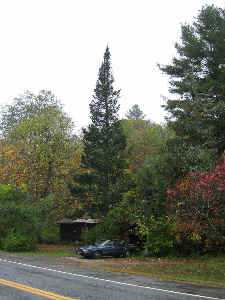 Staghorn Sumac at side of photo
Staghorn Sumac at side of photo
- photo by Will Blozan
Height: 28.57 feet (21 degrees at 17 yards plus 11 degrees at 18
yards)
CBH: 18" (25" lower on the main
trunk)
At the second roadside stop in addition to firs, Will, Jess, and
I also
measured several Quaking Aspens. The one I measured was 71.1
feet tall,
with a cbh of 35.5 inches.
After a nice dinner that evening I attended the second evening
of lectures
at the Forest Summit III. The first speaker was Dr. Lee
"Harbinger of
Doom" Frelich. Lee Frelich is from the University of
Minnesota, and
Director of the Center for Forest Ecology. Lee talked of the
wide variety
of pathogens, pests, and climatic changes that are going to
affect our
forests in the next fifty years. These included Hemlock Wooly
Adelgid,
Emerald Ash Borer, and other insects. Another
major invasive discussed in
detail were a variety of European earthworms that eat the duff
on the forest
floor, change the texture of the soil, and eat plants on the
forest floor.
Most of these invasion originated as fishing worms that were
dumped at lakes
and streams over the past hundred years or more. Some of the
most
destructive are of the family Lumbricidea. The name sounds like
an Italian
Mafia family - mob earthworms are taking over our forests.
Another major
effect he discussed was global warming. The warming climate may
push an
umber of species northward out of the United States entirely.
Trees are
adapted to a specific climate. Warming of the climate may push
trees out of
their ideal climatic setting faster than they can migrate
northward,
especially when the patchwork nature of our remaining forests
are
considered. So if the rate of climatic change is faster than the
tree
populations can migrate northward or adapt, the species may die
off under
the stress, given other environmental factors of disease, pest,
browsing,
earthworms also adversely affecting them. The basic conclusion
was if
things progress as they are now, our forests will be drastically
different
in fifty years. There will be an ecosystem, but it may be a much
simplified
version compared to the present day forests.
Dr. Thomas Diggins was up next. He is a professor of forest
ecology at
Youngstown State University. He is currently studying the unique
old growth
forests of Zoar Valley , NY. Tom shared some of his current
research
project within Zoar Valley. He started off by coining the term
Homo sapiens
dendrophilus to refer to various tree huggers. Two aspects of
the research
were highlighted. The first was a measurement of the orientation
of fallen
coarse woody debris - tree trunks, limbs, and branches. First
appearances
suggested that the debris fell randomly within the sheltered
valley.
Analysis of the data collected revealed that there was a strong
preferred
orientation at several localities. The valley opens to the west
and the
predominant direction of fall was to the east. The second major
aspect he
talked about was the age distribution of the trees along the
banks of the
stream. Different age groupings reflected the different ages of
bars, and
banks developed along the river flow path. Tom
had found aerial photos
from one site dating from 1920, and several photos from
subsequent years
that documented the progression of one area from open bar and
oxbow to
present day forest. Of interest to me were the stunted chestnut
oaks
growing from shale/clay deposits on the on bank of the valley.
Tony D'Amato presented next. He is a Doctoral Candidate in
Forestry at the
University of Massachusetts and is working with Harvard Forest
on his
dissertation research examining the dynamics, forest structural
attributes,
and ecosystem properties of old growth forests in western MA. I
really
enjoyed this presentation because Tony presented details of the
criteria he
used to define old growth areas in western Massachusetts. He
discussed the
distribution and characteristics of the old growth forest and
suggested how
it had managed to persist in these areas in spite of several
hundred years
of logging in the state. It was an excellent general overview of
the
subject and appropriate for people like myself who are either
not trained in
forestry or are unfamiliar with the details of the forests in
Massachusetts.
The final speaker for the evening was Will Blozan, President and
co-founder
of the Eastern Native Tree Society. Will talked about great
trees he had
seen, climbed, and measured. He had photos of the Middleton Oak,
SC, the
Yonaguska Hemlock, Gabes Mountain Hemlock, Sag Branch Tulip, and
a host of
other magnificent trees, The theme of the talk also considered
the volumes
of these trees, and where there was potential for trees to
approach or
exceed the volume of the Middleton Oak tree measured by a team
of ENTS (
including Will) in April 2004. It was a high note upon which to
end the
conference lectures. After closing remarks by Gary Beluzo, we
headed back
to Monica's for the night.
Ed Frank
|
| Forest
Summit III report (Part 2) |
Edward
Frank |
| Oct
24, 2005 13:42 PDT |
ENTS
Saturday morning found us on our way to Mohawk Trail State
Forest. I guess
it was this morning we met people for breakfast rather than
Friday. We met
John Eicholz, Howard Stoner, and Craig McAuslin at a restaurant
on the way.
I found several people, including PhD's were not able to order
eggs for me
while I went to the restroom. It was a drizzley day at Mohawk.
People were
dressed ion rain gear. Many people had umbrellas. Craig loaned
me one for
the day. We headed up the road from the park entrance to the
Massasoit pine
in the Pocumtuck Grove in MTSF. It grows at the edge of an open
field and
was the target for our measuring experiments. There
was an entire group of
us measuring away in the rain holding umbrellas.
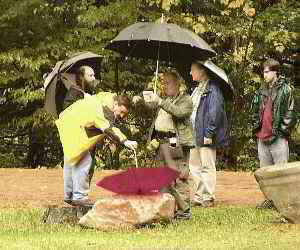
People in photo left to right: john Eicholz,
Tom Diggins, Bob Leverett, Lee Frelich, and Jess Riddle
- photo by Ed Frank |
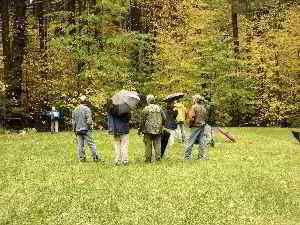 |
I sent Tom
Diggens a photo
of him in the rain. He replied back via email: "Nothing
says "cutting-edge
scientist" like my wife's mauve-colored umbrella!!"
Bob detailed the
measurements in a previous post.
I tried a variety of measuring methods.
My laser/clinometer measurements were pretty close to the actual
drop-tape
measurement of the tree. I tried the stick method and if you
look at the
figures, the one that is extremely high is the one I took. I
messed up the
mechanics of the experiment and perhaps the calculations would
be more
truthful if mine were excluded from the dataset (or maybe not as
we were
looking at error.)
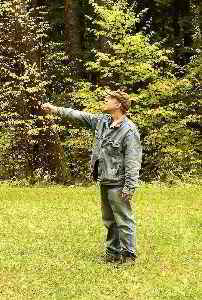 Carl Harting trying the stick method
Carl Harting trying the stick method
The drizzle
slowed for awhile, and since we had done all
of these measurements, Will set up to climb the tree. He threw a
weighted
bag up over limbs to set the rope. After a few tries and he was
off. I set
up top take pictures. I want to thank Susan and Craig who held
umbrellas
over my camera while I took pictures. The photos
of the climb tuned out Ok.
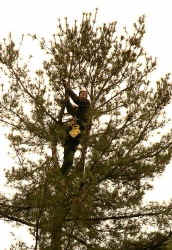 Will at top - photo by Ed Frank
Will at top - photo by Ed Frank
I had trouble determining the exposure for the shots through the
viewfinder of my
newly repaired Nikon 8700 digital camera. The image was dark
with light
flairs - I sent it back to Nikon after the trip for further
adjustments. I
shot many, many photos with varying light settings to try to
obtain decent
photos. Anyway, Will zipped up the tree, took a height
measurement, and
then measured a series of circumferences on his way down to
calculate tree
volume. He said the top of the tree was dry and he could see the
wind
drying out the bark as he waited in the top of the tree.
After Will returned to Earth several of us went for a hike
around Mohawk
Trail. Several pine trees were measured. We
visited the tall ash and and
half-rotted height champion sugar maple I saw the previous year.
We hiked
across the meadow with fall colored trees in the distance and
fall-colored
yellow sensitive fern carpeting sections of the field. Jess
Riddle
recognized this as an area I photographed last year and posted
to the
website. Lee pointed out various fern species and moss species
as we walked
along.
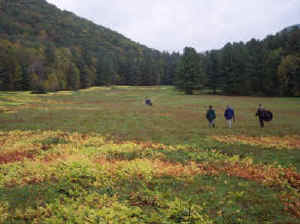
Meadow Area, MTSF with sensitive fern turned to
yellow - photo by Carl Harting |
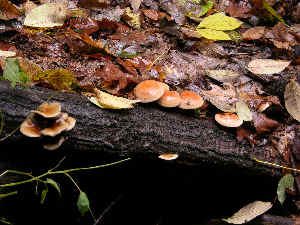
Fungi growing on a dead log, MTSF - photo by Ed Frank |
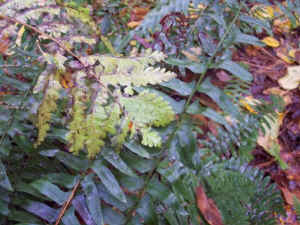
Interrupted and Christmas Ferns at MTSF - photo by
Carl Harting |
|
There were
numerous fungi growing in the wet forest as well. Two
trees of note stuck out in my mind. The first was a bigtooth
aspen. It
stood about 106 feet high and was 15 inches or so in diameter.
The bark was
rough and unlike any aspen bark I had seen before.
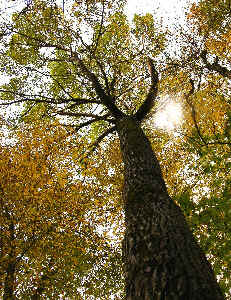
Bigtooth Aspen, 106 feet tall, MTSF - photo by Ed
Frank |
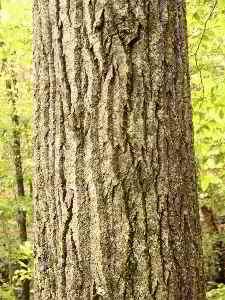
Bigtooth Aspen bark - photo by Ed Frank |
The second
was a tall
thin pine. As I walked by Will ask me to shake the tree so he
could better
distinguish it from its neighbors. The tree was 96 feet tall and
a little
over 7 inches in diameter. The resulting height to diameter
ratio was over
150:1. A very skinny tree. From there we headed back to the
vehicles and
off to dinner.
After dinner
we headed back to Monica's for the first ENTS concert. Monica
Jakuc is the Elsie Erwin Sweeney professor of music at Smith
College in
Northampton, MA. Monica has a large climate controlled music
room in her
home with a vaulted ceiling, sound absorption blocks, and two
pianos. She
organized the concert around the theme of New England and
woodlands.
Monica was featured on piano, Lee Frelich on the violin, and
Peter Shea sang as
tenor.
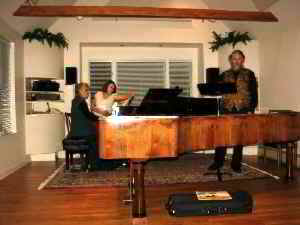
The concert
report and photos are listed on a separate
page.
Later that evening after the crowds had left, I had my first
chance to talk
with Jess Riddle. He is one of ENTS most prolific measurers in
southeastern
United States. I had corresponded with him for a couple of
years, but we
first met at the conference Thursday night. I had a photo I had
taken of a
large red cedar, the Kalaloch Cedar, in Washington state on my
laptop. Jess
recognized the same tree in a coffee table book on trees by Jim
Balog -
"Tree : A New Vision of the American Forest" (The tree
also appears in Bob
Van Pelt's: Forest Giants of the Pacific) . Jess's familiarity
with the
statistics of various record trees around the country is
amazing. He grew
up in Atlanta and recently graduated from Furman University.
Will, Lee, Jess, Carl, and I talked late into the night.
Finally I
said I was going to go to bed. Everyone rose in a single motion
and headed
off to sleep. I guess everyone was waiting for someone to be the
first to
retire. The next morning Carl and I headed out early for home.
We drove
through the Delaware Water Gap and stopped at Hickory Run State
Park, PA on
the way home. But that is another tale.
Ed Frank
|
| RE:
Forest Summit III report (Part 1) |
Gary
A. Beluzo |
| Oct
25, 2005 09:52 PDT |
Ed:
Great report on the Summit. actually Brudder Bob was the head
ENT to close
the show, after Will's dizzying tour of the high canopy of the
Smokies I
asked Bob to step up to explain ENTS to the uninitiated in the
audience and
add any closing remarks- Bob unabashedly rose to the occasion
with his
southern charm and self-deprecating humor..
Incidentally, we wouldn't have had a Forest Summit this year
without Bob's
uncanny ability to round up speakers par excellence, his
indefatigable
evangelism to get folks to the Summit, and his powers of
persuasion to keep
me going after major surgery in late August and a delayed
recovery in
September-early October. Thanks Bob!
Gary
|
|